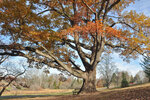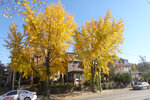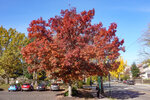"Philadelphia Trees," the newly reprinted field guide to the trees of the Philadelphia region, arrives at an opportune time.
This item is available in full to subscribers.
We have recently launched a new and improved website. To continue reading, you will need to either log into your subscriber account, or purchase a new subscription.
If you are a digital subscriber with an active subscription, then you already have an account here. Just reset your password if you've not yet logged in to your account on this new site.
If you are a current print subscriber, you can set up a free website account by clicking here.
Otherwise, click here to view your options for subscribing.
Please log in to continue |



Philadelphia Trees, the newly reprinted field guide to the trees of the Philadelphia region by Paul Meyer, Catriona Briger and Edward Barnard, arrives at an opportune time. Many of the majestic green giants it features are now in full color – and putting on a spectacular show.
And according to its authors, the new edition of this book is their way of helping us all to appreciate what a gift they are – particularly here in the Northwest. Because many of our older and most majestic trees are in need of our help.
“The Northwest is blessed with a mature urban forest, which gives us a sense of our particular place and is really something most of us value,” said Meyer. “The downside of all that maturity is that old trees do die, so we can’t be complacent. We need to think about replacing these trees with new and younger ones, trees that will eventually grow to become the heritage trees of the future.”
And it’s not just age. Our trees are under stress for a variety of reasons, including invasive pests, deferred maintenance, the stress of being in an urban environment as well as a gradually warming climate.
“We have inherited a wonderful legacy of trees, planted and nourished by earlier generations,” Meyer said. “They are not just beautiful, they’re vital to our health, our environment and our very sense of place. They provide us with so much. Without our help, our older trees will pass on and our urban forest will fade away.”
Philadelphia was rich with trees – oaks, chestnuts, maples and many more – when William Penn first founded the city in 1682. Its lush forests became a focus of interest as well as industry, and by the late 18th century the region had become a hub for botanical knowledge. By the 19th century, it had become the virtual center for botany – drawing curious visitors from all over the world.
Many of the species they would have seen are still with us today. Take the majestic Black Walnut, a native species with its telltale ridged bark and compound leaves. In the fall, the ground beneath this giant is littered with its namesake nuts, encased in a leathery green husk that stains a deep brown upon touch. There’s the ubiquitous Eastern White Pine, a true Philadelphia native with soft, bluish-green needles that can tower up to 80 feet or more. There are Black Gums and Tulip Poplars, and the grand Silver Maple, with its shimmering leaves, green on top and silvery-white underneath. Less common but equally captivating trees are the Kentucky Coffeetree and the Osage Orange, one named for its hard, bean-like seeds that early settlers used as a coffee substitute and the other, which draws attention for its unusual, large, wrinkly fruit and thorny branches.
“I am particularly fond of the White Oak,” Meyer said. “It has beautiful leaves, and when they grow out in the open they tend to have wide, spreading branches.”
It also tends to be rather slow-growing, so many people choose not to plant it.
“But that’s why those are the future heritage trees,” Meyer said. “They grow slowly, but live a long time.”
Some species are newer, brought by generations of horticulturalists. Lucky for Philadelphia, these include one of the city’s most common street trees, the hybrid species of Sycamore known as the London Plane Tree. It’s one of the toughest urban trees and the most stress-tolerant – two of the newer selections that have increased resistance to disease have recently been planted in Pastorius Park.
“These hybrids have been planted all over the world,” Meyer said. “It's a really good tree that's going to tolerate the effects of climate change, including flooding, warming and drought” as well as the urban stresses of reflected heat, limited soil volume and de-icing salts.
Other species, however, are not so lucky.
“Of all of our trees, the species I am the most worried about losing is the sugar maple,” Meyer said. “It’s a more northerly tree and does not tolerate the stress of warming climate, drought or de-icing salts very well.”
Meyer was still executive director of the Morris Arboretum when Ned Bernard, who had written a similar book about the trees of New York City, asked if he would be interested in collaborating and what would become the first edition of the field guide, which was published in 2018.
That edition was a big success and sold out quickly. And when the time came for a reprint, they realized they’d need an update.
“Quite a few of the majestic old trees we had featured in the first edition were gone, and had changed, or even died – including the Sugar Maple on the Belmont Plateau that we had featured on the cover.”
They died for the same mix of reasons that all of the region’s trees are now coping with – climate change, urban stress, invasive pests and new diseases.
“But it’s also just the plain fact that many of the trees we featured in the original edition were mature, majestic heritage trees. And mature trees are sort of like mature people. Eventually, they die. In many cases it was simply a question of age.”
Not to sound like a broken record, Meyer said, that’s exactly why he’s hoping the handbook will get people to stop, look around, and realize how much they value their trees.
“The simple acts of planting and tending a tree can have a profound, positive impact on your community for generations to come,” he said.